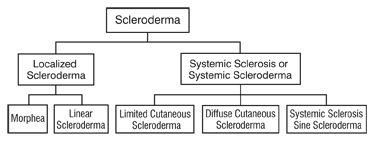Tight Skin
Sat, 31 May 2008 17:55:07
Guide to treatment of Scleroderma
Scleroderma
Publication Date: May 2001
Revised July 2006
Handout on Health: Scleroderma
This article is for people who have scleroderma, as well as for their family members, friends, and others who want to find out more about the disease.
What Is Scleroderma?
Derived from the Greek words "sklerosis," meaning hardness, and "derma," meaning skin, scleroderma literally means hard skin. Though it is often referred to as if it were a single disease, scleroderma is really a symptom of a group of diseases that involve the abnormal growth of connective tissue, which supports the skin and internal organs. It is sometimes used, therefore, as an umbrella term for these disorders. In some forms of scleroderma, hard, tight skin is the extent of this abnormal process. In other forms, however, the problem goes much deeper, affecting blood vessels and internal organs, such as the heart, lungs, and kidneys.
Scleroderma is called both a rheumatic (roo-MA-tik) disease and a connective tissue disease. The term rheumatic disease refers to a group of conditions characterized by inflammation and/or pain in the muscles, joints, or fibrous tissue. A connective tissue disease is one that affects tissues such as skin, tendons, and cartilage.
In this booklet we'll discuss the forms of scleroderma and the problems associated with each of them, as well as diagnosis and disease management. We'll also take a look at what research is telling us about their possible causes and most effective treatments. And we will describe ways for people with scleroderma to live longer, healthier, and more productive lives.
What Are the Different Types of Scleroderma?
The group of diseases we call scleroderma falls into two main classes: localized scleroderma and systemic sclerosis. (Localized diseases affect only certain parts of the body; systemic diseases can affect the whole body.) Both groups include subgroups. (See chart.) Although there are different ways these groups and subgroups may be broken down or referred to (and your doctor may use different terms from what you see here), the following is a common way of classifying these diseases:
Types of Scleroderma

Have any questions or need help then please see services section
